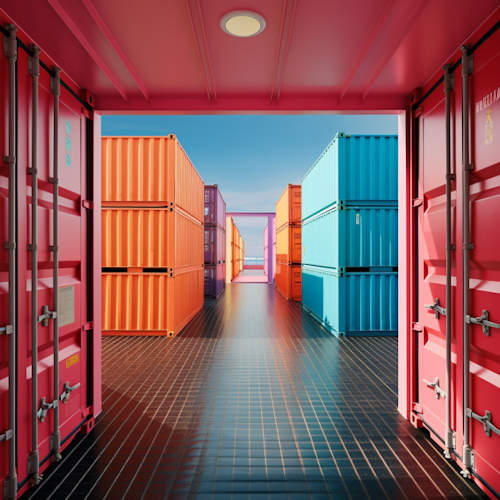Containers Reimagined: Bridging Global Trade and Environmental Stewardship

The Evolution of Container Technology
Imagine a world where goods were individually loaded onto ships, trains, or trucks—a labor-intensive, inefficient, and time-consuming process. This was the reality before the advent of the shipping container. Since its inception, this standardized steel box, though unassuming in appearance, has radically transformed the global trade landscape.
* Please send feedback/suggestions to editor @ shipuniverse.com
The shipping container, while seemingly mundane, has been a revolutionary invention in the world of logistics and transportation. Malcolm McLean, an American entrepreneur, is often credited with its creation in the mid-20th century. He envisioned a streamlined and unified way to transport goods across multiple modes of transport—ship, rail, and road—without continuous loading and unloading.
Over the ensuing decades, the shipping container has evolved in response to industry needs, economic challenges, and global demands. From its standard size and shape to the materials used, every aspect of the container has seen enhancements aimed at increasing its efficiency and durability. The globalized world we live in today, with products sourced from every corner of the globe, owes much of its existence to these steel boxes.
In this era, as sustainability concerns and technological advancements come to the forefront, the shipping container is poised for yet another transformation. Today, as we navigate the intricate lanes of global commerce, we’ll delve into the latest trends and innovations in container technology that are shaping the future of shipping. Join us as we embark on this journey, exploring the past, present, and the promising future of these essential trade facilitators.
New Design Advancements
In the bustling ports and vast shipyards worldwide, a quiet revolution is taking place. Gone are the days when one-size-fits-all shipping containers dominated the scene. As the nature of global commerce shifts and the variety of products being shipped broadens, there’s a pressing need for containers that can adapt to diverse cargo requirements.
The shipping industry, renowned for its resilience and adaptability, continues to innovate in the face of these changing demands. With the burgeoning growth and diversification of the industry, there is a call for fresh, advanced designs that can cater to the unique needs of modern shipping.
Maximizing Space: A primary challenge for shippers has always been the efficient utilization of space. Modern container designs are rising to the challenge, with some featuring adjustable walls or multi-level structures that allow for optimized stowage of goods, ensuring that every inch of space is put to good use.
Enhanced Structural Integrity: With the increasing variety of goods being shipped, containers need to be more resilient than ever. New materials and design principles are being incorporated to ensure that these containers can withstand varied pressures and conditions, be it heavy machinery or delicate electronics.
Easier Handling and Versatility: The logistics of moving containers, whether in ports or inland depots, can be complex. Newer designs are incorporating features like reinforced corner posts, ergonomic handles, and standardized fittings to speed up the handling process. Additionally, innovations like collapsible or modular containers are gaining traction. These designs can be adjusted based on the cargo size, providing unparalleled flexibility. Such containers are especially beneficial for cargoes that don’t conform to standard sizes.
Specialized Containers for Niche Markets: While standard containers continue to play a pivotal role, there’s a growing demand for specialized containers tailored for specific industries. Whether it’s temperature-controlled containers for perishables or reinforced designs for heavy machinery, these specialized containers ensure that goods reach their destination in optimal condition.
In conclusion, as the world of commerce continues to evolve, the shipping industry is poised to meet its challenges head-on. Through innovative designs and a focus on efficiency, the next generation of shipping containers promises to be more adaptable, resilient, and versatile than ever before.
Materials: Moving Beyond Traditional Steel
For decades, the iconic image of a shipping container has been one of robust, corrugated steel boxes stacked high on cargo ships, traveling across vast oceans. The choice of steel as the primary material for these containers was a natural one. Steel offers strength, durability, and a certain resistance to the elements. But as time has progressed, the challenges and demands faced by the shipping industry have grown, shedding light on the limitations of traditional steel containers.
The Limitations of Steel: While steel’s strength is unquestionable, its susceptibility to corrosion, especially in salty marine environments, is a significant drawback. Furthermore, the weight of steel containers adds to fuel consumption during transport, thereby increasing the operational costs and environmental impact. And in today’s age of environmental consciousness, the carbon footprint associated with producing and recycling steel has come under scrutiny.
The Rise of Composite Materials: Responding to the need for lighter yet durable alternatives, the industry is turning its attention to composite materials. These materials, often a blend of resins and fibers, provide a unique combination of strength and lightness. Not only do they resist corrosion better than steel, but their reduced weight also translates to fuel savings and, consequently, fewer carbon emissions.
Anti-Corrosive Coatings: While some in the industry are exploring new base materials, others are focused on improving the steel container’s longevity. Advanced anti-corrosive coatings have been developed that can shield steel from the harshest environments, effectively extending the container’s lifecycle and reducing the need for frequent replacements.
Eco-Friendly and Biodegradable Materials: Perhaps the most exciting development in container materials is the exploration of eco-friendly and even biodegradable options. Imagine a container that, at the end of its life cycle, can decompose without leaving a lasting environmental impact. While still in nascent stages, the promise of such materials is a testament to the industry’s commitment to a sustainable future.
In summary, as the shipping industry navigates the challenges of the 21st century, a reevaluation of the materials that have long defined it is underway. The quest for sustainable, efficient, and durable containers is driving innovations that are set to redefine the face and function of global logistics.
Eco-Friendly Features and Sustainable Practices
As the clarion call for environmental responsibility reverberates worldwide, industries across the board are reevaluating their practices, looking for ways to lessen their ecological footprint. The shipping industry, responsible for moving approximately 90% of the world’s goods, is no exception to this global shift.
Harnessing Renewable Energy: Modern containers are no longer just passive storage boxes. They’re being equipped with state-of-the-art technologies to minimize their environmental impact. A shining example of this is the integration of solar panels on containers. These panels can harness sunlight, converting it into electricity to power tracking devices, internal climate controls, or even lighting. This not only reduces the need for external power sources but also decreases the carbon footprint of container operations.
Environmentally-Safe Materials: As we’ve touched upon with new material explorations, the industry’s commitment to the environment is also evident in its choice of coatings and paints. Traditional paints, often laden with harmful chemicals, are being phased out in favor of environmentally-safe alternatives. These new-generation paints not only reduce environmental harm but often come with added benefits like increased resistance to wear and tear.
Upcycling and Repurposing: The life of a shipping container doesn’t end once it’s deemed unfit for maritime transport. A significant trend in sustainability is the upcycling of old containers. These steel giants are being transformed into innovative structures, from modern housing solutions and office spaces to trendy pop-up shops and cafes. By repurposing containers in this manner, the industry is effectively extending their lifecycle, reducing waste, and promoting a culture of reuse.
Promoting a Circular Economy: Beyond individual containers, the shipping industry is exploring practices that promote a circular economy. This involves creating a closed-loop system where containers are continually reused, refurbished, and recycled, ensuring minimal wastage and environmental impact.
As the world grapples with pressing environmental concerns, the shipping industry is rising to the occasion. The shipping container, a symbol of global trade, is at the forefront of this transformation. These ongoing innovations showcase a commitment not just to efficiency and operational excellence but to a vision of a sustainable, eco-conscious future. It’s a testament to the industry’s recognition that the health of our planet is intrinsically linked to the future of global commerce.
How Different Regions are Innovating Shipping Containers
In the vast realm of global trade, the shipping container is the unsung hero, silently facilitating the movement of goods across continents. As sustainability and efficiency become the watchwords of the 21st century, different regions have taken unique approaches to innovate and adapt these metal giants. This article sails through the innovative waters of Scandinavia and Asia to explore their distinctive contributions.
Scandinavia: The Pioneers of Sustainable Innovation
Eco-Friendly Materials: Scandinavia, known for its commitment to environmental sustainability, has led the way in researching and developing eco-friendly materials for container construction. These nations are experimenting with bio-based polymers and other sustainable materials that reduce environmental impact and promise longer container lifespans.
Green Ports: Ports in Scandinavia, like the Port of Gothenburg, are working towards becoming ‘green ports’. They encourage the use of electric cranes, solar-powered infrastructure, and other green technologies that reduce the carbon footprint associated with container handling.
Upcycling Initiatives: Scandinavians have been at the forefront of turning old containers into sustainable housing, public spaces, and even urban farms, thereby promoting a culture of reuse and minimizing waste.
Asia: Harnessing Technology and Versatility
Smart Containers: Asian hubs, with their tech-driven ecosystems, are pioneering the integration of IoT (Internet of Things) into containers. With embedded sensors and tracking devices, these ‘smart containers’ offer real-time monitoring, ensuring cargo safety and efficient handling.
Modular Design: Asian manufacturers, aiming to cater to the varied demands of global trade, are leading in the production of modular containers. These designs can be adjusted based on cargo size, making them especially useful for diverse consignments.
Port Automation: Ports like Singapore’s Tuas Mega Port are embracing automation, using AI-driven systems for container sorting and handling. This not only speeds up the shipping process but also ensures precision and reduces human error.
A Confluence of Ideas
What emerges from this exploration is a fascinating confluence of ideas and initiatives. While Scandinavia leans heavily into its environmental ethos, pioneering sustainable solutions, Asia leverages its technological prowess to redefine efficiency and versatility in container handling.
Yet, the essence of these innovations, irrespective of their geographical origins, is a shared vision: to make global trade more efficient, sustainable, and responsive to the challenges of the modern world.
The journey of the shipping container, from its humble steel beginnings to the innovative marvels of today, reflects the ever-evolving nature of human ingenuity. As we witness different regions contributing their unique flavors to this global tapestry, it’s clear that the future of shipping containers is not just about moving goods, but moving ideas, values, and visions for a better, interconnected world.

Do you have a Maritime Product or Service that may be of interest to Shipowners? Tell us about it here!
Do you have feedback or insights? Please reach out to editor @ shipuniverse.com



